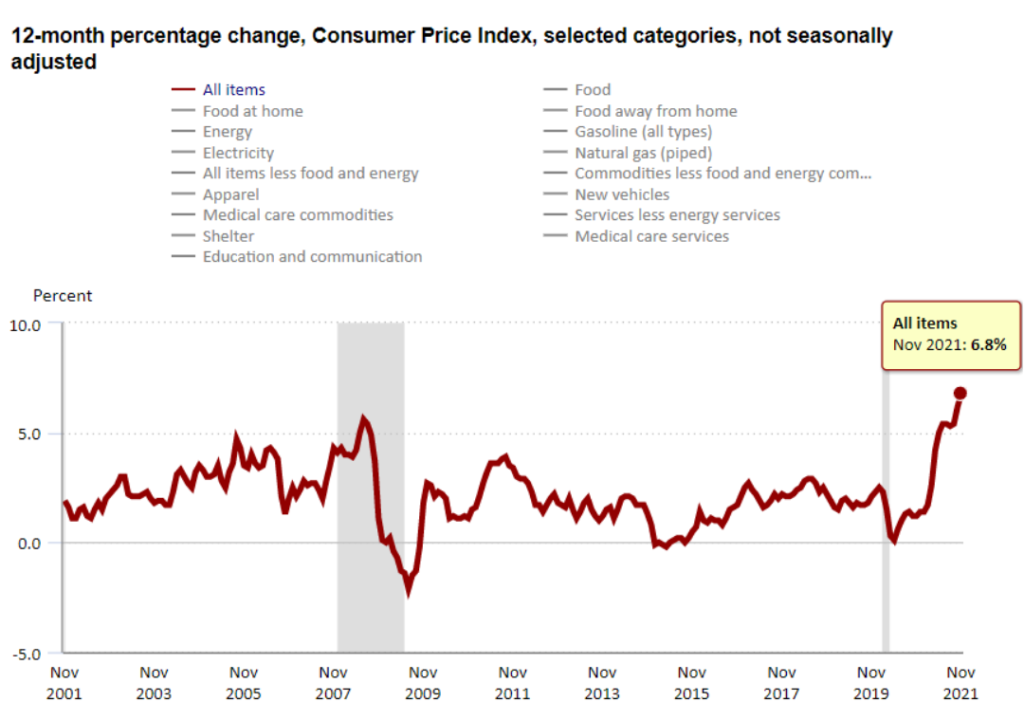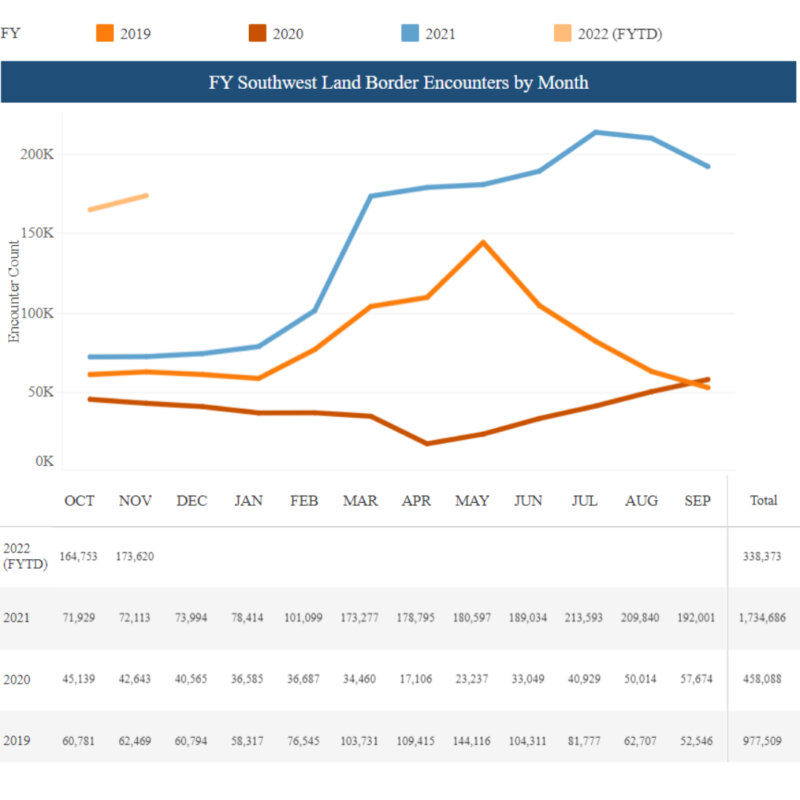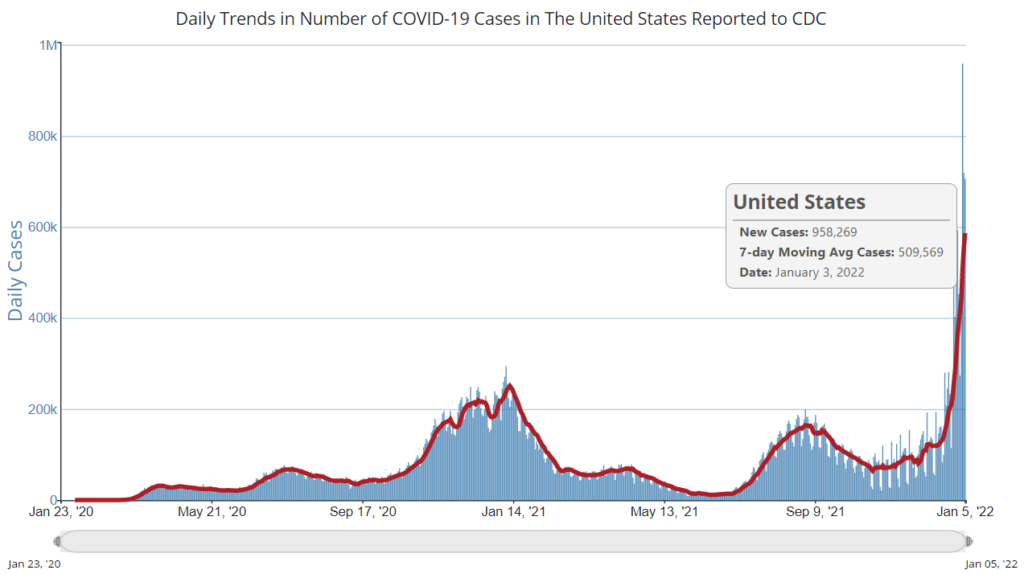2022 is here!
While the world continues to grapple with the effects of the COVID-19 pandemic and America prepares to mark two years since the first U.S. laboratory-confirmed case of COVID-19 on January 20, the year ahead will be shaped by many news stories that touch upon a broad range of policy issues with widespread impact.
Here’s five we’re watching in January.
If you have additional news you think we should share, please send us an email.
INFLATION
Inflation hit a 39-year high in November, rising 6.8% from a year earlier. Numerous factors have contributed to the rise, including supply chain disruptions and labor shortages due to COVID-19.
Inflation is expected to slow in the coming months, but economists say it could take until the end of 2022 to return to the normal 2% pace. In the meantime, consumers are left to grapple with the price increases.
At the pump, GasBuddy expects the yearly national average gas price per gallon will rise from $3.02 in 2021 to $3.41 in 2022, peaking around $4.00 in the spring. Patrick De Haan, head of petroleum analysis at GasBuddy says the higher prices are “not necessarily bad news” but rather “a sign that the economy continues to recover from Covid-19.”
In addition to impacting the prices at the grocery checkout line, inflation has also impacted big-ticket items, like homes and cars. The average new car cost increased over 13% from November 2020 – November 2021, and home prices increased by a record 19.1% from October 2020 – October 2021.
In December, Federal Reserve Chairman Jerome Powell said the Fed will fight inflation with as many three interest rate hikes in 2022.
LEARN MORE: Read The Policy Circle Brief on Economic Growth
MIDTERM ELECTIONS
This November’s midterm elections will see all 435 seats in the House of Representatives (members serve two-year terms) and 34 seats in the 100-member Senate (members serve six-year terms) up for grabs. Voters in 36 states will also elect governors.

Currently, Democrats control both chambers of Congress. Republicans need to net just one seat to take back the majority in the Senate and five seats to take back the majority in the House.
If Republicans take the House, the Senate, or both, experts predict that would likely signal big trouble for the Biden administration’s legislative agenda (bills, like The Build Back Better Framework, must pass both chambers of Congress), any possible Supreme Court nominee (nominees must be approved by majority of the Senate), and potentially Democrats’ chances in the 2024 presidential election.
Historically speaking, the president’s party loses congressional seats during midterm elections. History aside, Republicans are optimistic about the midterm elections, pointing to President Biden’s approval ratings, the political fallout surrounding the economy and pandemic, and the 2021 state legislative elections, which saw GOP candidates score significant wins.
LEARN MORE: Read The Policy Circle’s Active Voter Guide
IMMIGRATION
In fiscal year 2021 (October 2020 – September 2021), U.S. Border Patrol encountered over 1.73 million migrants at the U.S.-Mexico border — the highest annual number on record. In July alone, there were more than 213,000 encounters, the highest monthly total in over two decades.
It’s important to note that “encounters” refers to several types of people, including those expelled (ex: over 1 million were expelled under a public health policy to prevent the spread of COVID-19) and those allowed to remain (ex: unaccompanied minors and asylum seekers pending disposition of their case). “Encounters” also includes those people who were previously expelled and attempted re-entry. Prior to COVID-19, about one in eight border encounters involved a person previously encountered during the prior year. Since March 2020, the repeat encounter rate jumped to more than one in three encounters.
Separate from the crisis along the border, America is facing an influx of refugees. The Trump administration set the limit for the number of refugees at 15,000, but the Biden administration raised the cap to 125,000 for fiscal year 2022. Excluded from that cap are the 74,000 Afghans resettled in America as of December in the wake of the chaotic end to the 20-year war in Afghanistan.
With the Biden administration set to welcome up to 95,000 Afghan refugees this year, questions remain about the social and economic impacts of refugee resettlement on receiving communities.
LEARN MORE: Read The Policy Circle Brief on Immigration
RUSSIA
On January 10, senior officials from the United States and Russia began talks over nuclear arms control and the military escalation along Ukraine’s eastern border. On January 12, Russia will meet with the North Atlantic Treaty Organization (NATO), the political and military alliance made up of the U.S., Canada, and 28 European countries.

Last week, Presidents Biden and Putin spoke ahead of the talks. Pres. Biden urged Russia to de-escalate tensions with Ukraine after Russia has continued to amass tens of thousands of troops along Ukraine’s border in recent weeks. He also “made clear that the United States and its allies and partners will respond decisively if Russia further invades Ukraine.” Three days later, Pres. Biden reaffirmed the commitment of the U.S. and its allies to help Ukraine during a phone call with Ukrainian President Volodymyr Zelensky.
In response, Pres. Putin warned against threatened sanctions. Russia says the military buildup near Ukraine is just to protect its border, and wants legally enforceable guarantees that NATO will stop eastward expansion and deny membership to Ukraine.
The latest threat to Ukraine comes as March will mark eight years since Russia seized part of southern Ukraine and illegally annexed Crimea.
COVID
2021 ended with the highest 7-day moving average of daily new cases (316,277) and the highest single-day total of new cases (486,428) on record.
Both records were broken in a matter of days. By January 3, the 7-day moving average of daily new cases rose to 509,569 and there were 958,269 new cases.
As of January 8, COVID-19 cases in the U.S. topped 59.5 million.
The current surge comes as 95% of new cases are linked to the hyper-contagious omicron variant sweeping the nation, while delta, the more severe variant, accounts for 5%. Omicron, although more mild than delta, can still cause severe infection.
Last week, hospitalizations averaged 14,776 per day, up nearly 63% from the week before, but still short of the peak 7-day average of 16,497 per day a year ago.
Questions linger about how the current surge, which coincides with this winter’s flu season, will impact the return to work and school amid soaring hospitalizations, overwhelmed health care systems, and staffing shortages following the holiday season.
Unable to access a COVID test? Check out this video to hear one doctor’s explanation on how to tell if you have the flu or COVID.
The Policy Circle is a 501(c)(3), nonpartisan organization that provides pathways for women to become courageous, knowledgeable and active citizens who identify and take ownership of local solutions to the issues facing their communities. Please consider supporting our mission and developing your own leadership skills by becoming a financial supporter.
Want to share your Policy Circle story? Email us at communications@thepolicycircle.org to learn how to get involved. And follow us on social: Facebook, Instagram, Twitter and LinkedIn.


